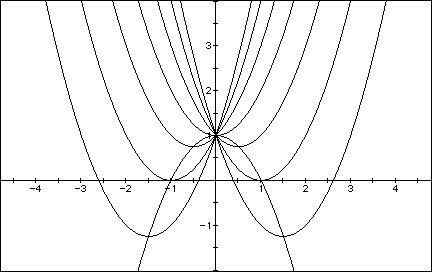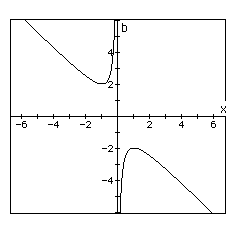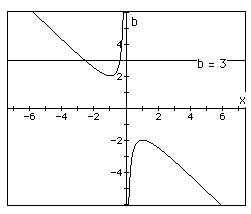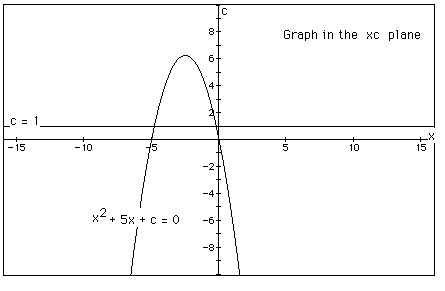and to overlay several graphs of
for different values of a, b, or c as the other two are held constant.
From these graphs discussion of the patterns for the roots of
can be followed. For example, if we set
for b = -3, -2, -1, 0, 1, 2, 3, and overlay the graphs, the following
picture is obtained.

We can discuss the "movement" of a parabola as b is changed.
The parabola always passes through the same point on the y-axis ( the point
(0,1) with this equation). For b < -2 the parabola will intersect the
x-axis in two points with positive x values (i.e. the original equation
will have two real roots, both positive). For b = -2, the parabola is tangent
to the x-axis and so the original equation has one real and positive root
at the point of tangency. For -1 < b < 2, the parabola does not intersect
the x-axis -- the original equation has no real roots. Similarly for b =
2 the parabola is tangent to the x-axis (one real negative root) and for
b > 2, the parabola intersets the x-axis twice to show two negative real
roots for each b.
Now consider the locus of the vertices of the set of parabolas graphed from
The vertex of a parabola can be obtained from the vertex formula: ![]() .
.
For the integers b within the interval [-3,3], we create the following functions:

Their corresponding verticies are:


If this is true, we can find the equation of a parabola in which these
points are solutions. The standard form for the equation of a parabola is
Where (h, k) is the vertex. This yeilds the equation:
We can find a by using any other point on the parabola. Substitute
the point ![]() into the equation.
into the equation.
Therefore , the equation of the parabola is:
Before we generalize, let us consider another set of parabolas,
for b within the interval [-3, 3]. We create the following set of equations:

The overlay of their graphs create the following picture.

These parabolas have the following verticies, respectively:

We can use these points and find the locus to be the quadratic equation:
![]() .
.
It seems that the vertex of the locus will always be the y-intercept of
the graph of
Consider again the equation
If we solve for b, we get the relation:
Now graph this relation in the xb plane. We get the following graph.

If we take any particular value of b, say b = 3, and overlay this equation
on the graph we add a line parallel to the x-axis. If it intersects the
curve in the xb plane the intersection points correspond to the roots of
the original equation for that value of b. We have the following graph.

For each value of b we select, we get a horizontal line. It is clear
on a single graph that we get two negative real roots of the original equation
when b > 2, one negative real root when b = 2, no real roots for -2 <
b < 2, One positive real root when b = -2, and two positive real roots
when b < -2. We can easily see the reason behind this by looking at the
discriminant of the original equation:
The discriminant is: ![]() , which simplifies to
, which simplifies to ![]() .
.
If the discriminant is postitive, there are two distinct real roots. If
it equals zero, there is one repeated real root. If it is negative, there
are no real roots. When we solve the relations

we see why there are two negative real roots when b > 2, one negative
real root when b = 2, no real roots for -2 < b < 2, One positive real
root when b = -2, and two positive real roots when b < -2.
Consider the case when c = - 1 rather than + 1.
In the following example the equation
is considered. If the equation is graphed in the xc plane, it is easy
to see that the curve will be a parabola. For each value of c considered,
its graph will be a line crossing the parabola in 0, 1, or 2 points -- the
intersections being at the roots of the orignal equation at that value of
c. In the graph, the graph of c = 1 is shown. The equation
will have two negative roots -- approximately -0.2 and -4.8.

There is one value of c where the equation will have only 1 real root -- at c = 6.25. For c > 6.25 the equation will have no real roots and for c < 6.25 the equation will have two roots, both negative for 0 < c < 6.25, one negative and one 0 when c = 0 and one negative and one positive when c < 0.